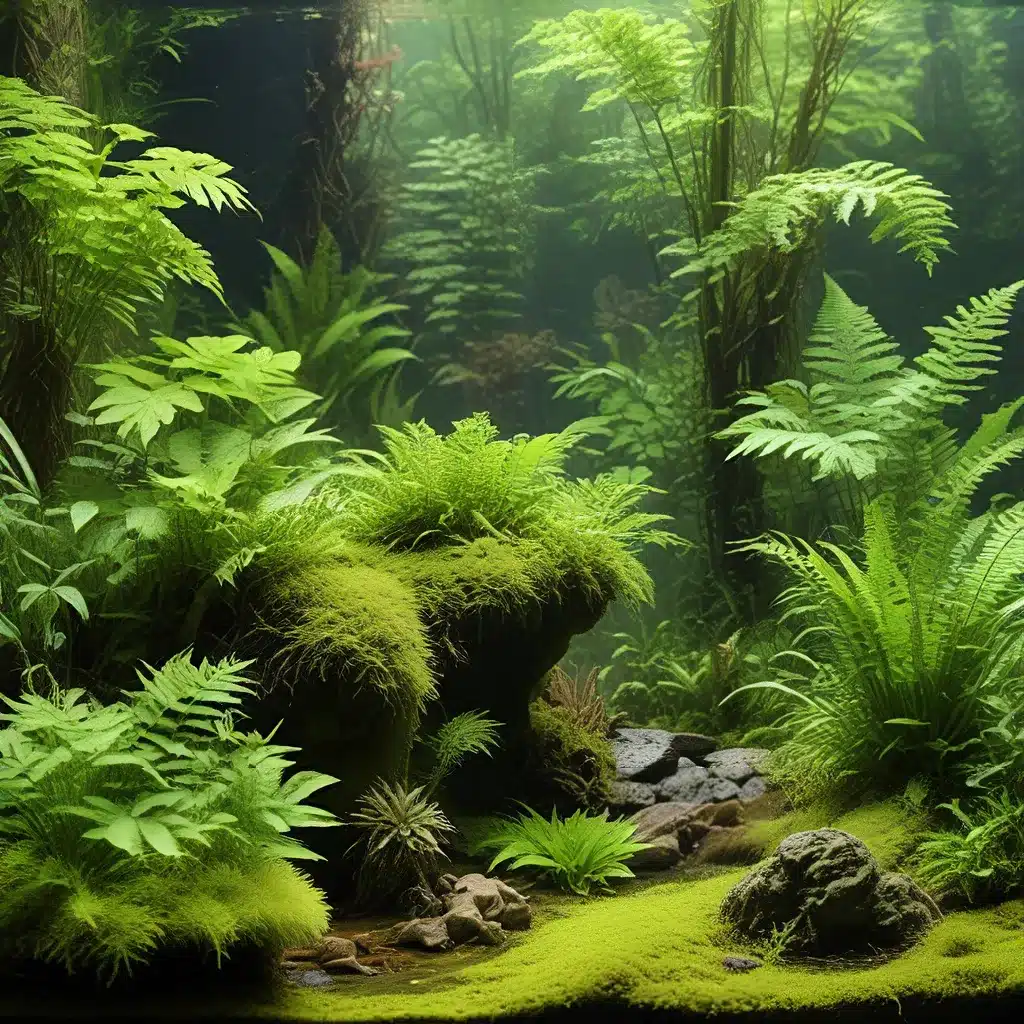
Aquatic Moss and Fern Care: Elevating Your Aquascape
Aquascaping is an art form that allows aquarium enthusiasts to create captivating underwater landscapes. At the heart of this practice lies the strategic use of aquatic plants, including mosses and ferns, which can transform a simple tank into a lush, naturalistic oasis. In this comprehensive guide, we’ll explore the unique characteristics and care requirements of these enchanting aquatic species, along with techniques to seamlessly integrate them into your aquascaping designs.
The Allure of Aquatic Mosses and Ferns
Aquatic mosses and ferns are renowned for their delicate, intricate foliage and the serene ambiance they bring to aquarium environments. These plants thrive in a wide range of water conditions, making them accessible to hobbyists of all skill levels. Aquatic mosses, such as Fissidens and Vesicularia (Java Moss), form soft, cascading mats that cling to driftwood, rocks, and other hardscaping elements. In contrast, aquatic ferns like Salvinia Natans float gracefully on the water’s surface, creating a lush, verdant carpet.
Beyond their aesthetic appeal, these plants also play a vital role in maintaining a healthy aquatic ecosystem. Aquatic mosses and ferns are effective natural water purifiers, absorbing excess nutrients like nitrates and phosphates, which helps prevent the overgrowth of harmful algae. Additionally, they provide valuable hiding spots and spawning grounds for small fish and invertebrates, fostering a diverse and thriving aquarium community.
Aquascaping with Mosses and Ferns
When it comes to aquascaping, aquatic mosses and ferns offer a wealth of opportunities to enhance the visual appeal and depth of your underwater landscape. These plants can be strategically positioned to create focal points, add texture and contrast, and guide the viewer’s eye through the aquascape.
Moss Carpets and Cascades
Spreading a carpet of lush, green moss across the substrate or draping it over driftwood and rocks can instantly elevate the naturalistic feel of your aquascape. The delicate fronds of mosses like Fissidens and Vesicularia create a soft, velvety texture that complements the hardscape elements and provides a visually stunning contrast to the vibrant colors of stem plants.
For a more dramatic effect, you can use mosses to create cascading waterfalls or hanging gardens along the aquarium’s walls or decorative structures. This technique not only adds depth and visual interest but also mimics the natural beauty of terrestrial moss-covered rocks and tree branches.
Floating Fern Accents
Floating aquatic ferns like Salvinia Natans can be strategically placed to provide a lush, verdant backdrop or to frame specific areas of your aquascape. Their floating nature allows them to create a sense of depth and draw the viewer’s attention to specific focal points, while their gentle movement along the water’s surface adds a captivating dynamism to the overall composition.
Harmonizing Hardscapes
Aquatic mosses and ferns excel at enhancing the natural appearance of hardscape elements like driftwood, rocks, and branches. By attaching or allowing the plants to grow over these structures, you can create a seamless integration between the living and non-living components of your aquascape, resulting in a cohesive and visually stunning display.
Maintaining Aquatic Mosses and Ferns
Proper care and maintenance are essential for ensuring the long-term health and vibrant appearance of aquatic mosses and ferns in your aquascape. Here are some key considerations:
Water Parameters
Aquatic mosses and ferns generally thrive in a wide range of water parameters, making them suitable for both freshwater and brackish aquarium environments. However, maintaining stable pH, temperature, and nutrient levels is crucial to their success. Aim for a pH between 6.0 and 7.5, with a temperature range of 68-82°F (20-28°C).
Lighting and Placement
These plants require moderate to high lighting levels to maintain their lush, green appearance. Positioning them in areas with ample, indirect lighting, either near the surface or along the aquarium’s walls, will help them thrive. Avoid direct, intense sunlight, as it can lead to excessive growth or discoloration.
Pruning and Propagation
Regular pruning is necessary to keep aquatic mosses and ferns in check and maintain their desired shape and coverage. Gently trim or pluck away any overgrown or discolored portions to encourage new, healthy growth. Additionally, these plants can be easily propagated by separating and replanting the individual fronds or plantlets, allowing you to expand their coverage throughout your aquascape.
Nutrient and Water Flow
Providing a balanced supply of essential nutrients, such as nitrogen, phosphorus, and potassium, will support the robust growth of aquatic mosses and ferns. Supplementing your aquarium with liquid fertilizers or introducing nutrient-rich substrates can be beneficial. Additionally, ensuring adequate water circulation will prevent stagnation and promote nutrient distribution throughout the aquascape.
By mastering the art of aquascaping with aquatic mosses and ferns, you can elevate your aquarium’s natural beauty and create a serene, captivating underwater oasis. Whether you’re a seasoned aquarist or a newcomer to the hobby, these versatile plants offer endless opportunities to explore your creativity and bring your aquascaping dreams to life.
Remember, the beauty of aquascaping lies not only in the final result but also in the journey of experimentation, learning, and discovering the unique characteristics of each aquatic plant. So, embrace the enchanting world of aquatic mosses and ferns, and let them transform your aquarium into a true work of living art.

